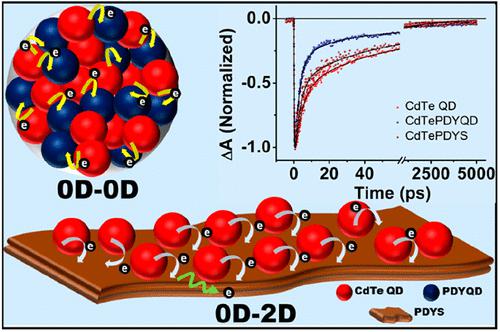当前位置:
X-MOL 学术
›
J. Phys. Chem. C
›
论文详情
Our official English website, www.x-mol.net, welcomes your
feedback! (Note: you will need to create a separate account there.)
Ultrafast Charge Transfer Dynamics and Charge Transport with Pyrediyne (PDY): Revealing the Role of a Novel Carbon-Based Electron Acceptor
The Journal of Physical Chemistry C ( IF 3.3 ) Pub Date : 2022-06-17 , DOI: 10.1021/acs.jpcc.2c00887 Malay Krishna Mahato 1 , Jyothibabu Sajila Arya 1 , Subhajit Nandy 2 , C. Sudakar 2 , Edamana Prasad 1
The Journal of Physical Chemistry C ( IF 3.3 ) Pub Date : 2022-06-17 , DOI: 10.1021/acs.jpcc.2c00887 Malay Krishna Mahato 1 , Jyothibabu Sajila Arya 1 , Subhajit Nandy 2 , C. Sudakar 2 , Edamana Prasad 1
Affiliation

|
Coupling of semiconductor quantum dots (QD) with carbon-based materials such as graphene, fullerene, carbon nanotube, and graphdiyne (GDY) has been proven to be an effective strategy to improve the performance of the photovoltaics due to the efficient charge extraction and enhanced charge transport of carbon-based materials. Analogous to GDY, recently, a new material known as pyrediyne (PDY) was reported from our group where pyrene rings are interconnected through a diacetylinic linkage. Although GDY has largely been explored in various fields including photovoltaics, battery, and superhydrophobicity, PDY has not been explored so far except for bioimaging application, largely because of the lack of understanding on the electronic behavior in the PDY interface. In this study, detailed charge transfer dynamics of CdTe QDs is investigated to understand the electronic process in the PDY interface in the presence of 0D PDY (PDYQD) and 2D PDY (PDYS) by using a combination of steady-state and time-resolved ultrafast spectroscopy measurements. The analysis provides an evidence for fast electron transfer from CdTe QDs to PDYQD. In addition, slow charge recombination of the transferred electron with the existing hole in CdTe QDs is evidenced as PDYS accepts the electron at a relatively slower rate. On the basis of the mechanistic investigation, an overall charge transfer scheme is proposed that accounts for the faster bleach recovery at an early time (picoseconds) and slower decay at a longer time (nanoseconds) scale. In addition, to ensure the applicability of PDY in real devices, four-probe photoconductivity measurements were employed, which shows improved photoconductivity (from σ = 1.53 × 10–6 to σ = 5.10 × 10–6 S m–1) for CdTe-PDYQD. These findings are very promising to advance both the design and the application scope of PDY in the field of clean energy research to enhance the device performances.
中文翻译:

超快电荷转移动力学和吡啶 (PDY) 电荷转移:揭示新型碳基电子受体的作用
半导体量子点 (QD) 与石墨烯、富勒烯、碳纳米管和石墨二炔 (GDY) 等碳基材料的耦合已被证明是提高光伏性能的有效策略,因为它可以有效地提取电荷并增强碳基材料的电荷传输。与 GDY 类似,最近,我们小组报道了一种称为吡啶二炔 (PDY) 的新材料,其中芘环通过二乙炔键相互连接。尽管 GDY 已在包括光伏、电池和超疏水性在内的各个领域进行了广泛的探索,但迄今为止,除了生物成像应用之外,PDY 尚未得到探索,这主要是因为对 PDY 界面中的电子行为缺乏了解。在这项研究中,通过结合使用稳态和时间分辨超快光谱测量,研究了 CdTe QD 的详细电荷转移动力学,以了解在 0D PDY (PDYQD) 和 2D PDY (PDYS) 存在下 PDY 界面中的电子过程。该分析为从 CdTe QD 到 PDYQD 的快速电子转移提供了证据。此外,转移电子与 CdTe 量子点中现有空穴的缓慢电荷复合被证明是因为 PDYS 以相对较慢的速率接受电子。在机理研究的基础上,提出了一种整体电荷转移方案,该方案说明了早期(皮秒)较快的漂白剂恢复和较长时间(纳秒)范围内较慢的衰减。此外,为保证 PDY 在真实设备中的适用性,–6到 σ = 5.10 × 10 –6 S m –1 ) 对于 CdTe-PDYQD。这些发现非常有希望推动 PDY 在清洁能源研究领域的设计和应用范围,以提高器件性能。
更新日期:2022-06-17
中文翻译:

超快电荷转移动力学和吡啶 (PDY) 电荷转移:揭示新型碳基电子受体的作用
半导体量子点 (QD) 与石墨烯、富勒烯、碳纳米管和石墨二炔 (GDY) 等碳基材料的耦合已被证明是提高光伏性能的有效策略,因为它可以有效地提取电荷并增强碳基材料的电荷传输。与 GDY 类似,最近,我们小组报道了一种称为吡啶二炔 (PDY) 的新材料,其中芘环通过二乙炔键相互连接。尽管 GDY 已在包括光伏、电池和超疏水性在内的各个领域进行了广泛的探索,但迄今为止,除了生物成像应用之外,PDY 尚未得到探索,这主要是因为对 PDY 界面中的电子行为缺乏了解。在这项研究中,通过结合使用稳态和时间分辨超快光谱测量,研究了 CdTe QD 的详细电荷转移动力学,以了解在 0D PDY (PDYQD) 和 2D PDY (PDYS) 存在下 PDY 界面中的电子过程。该分析为从 CdTe QD 到 PDYQD 的快速电子转移提供了证据。此外,转移电子与 CdTe 量子点中现有空穴的缓慢电荷复合被证明是因为 PDYS 以相对较慢的速率接受电子。在机理研究的基础上,提出了一种整体电荷转移方案,该方案说明了早期(皮秒)较快的漂白剂恢复和较长时间(纳秒)范围内较慢的衰减。此外,为保证 PDY 在真实设备中的适用性,–6到 σ = 5.10 × 10 –6 S m –1 ) 对于 CdTe-PDYQD。这些发现非常有希望推动 PDY 在清洁能源研究领域的设计和应用范围,以提高器件性能。











































 京公网安备 11010802027423号
京公网安备 11010802027423号